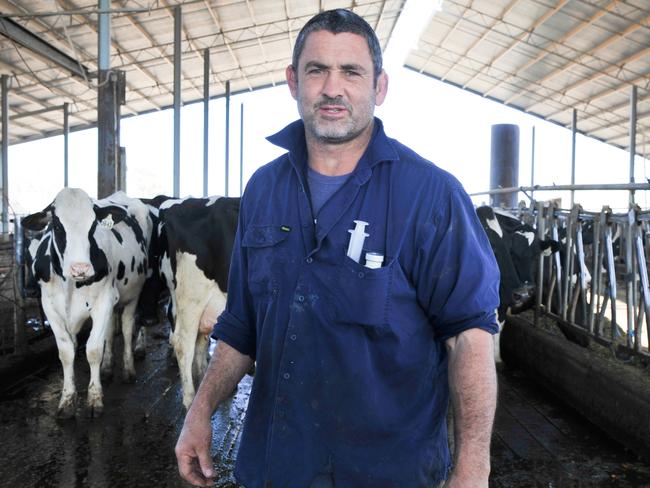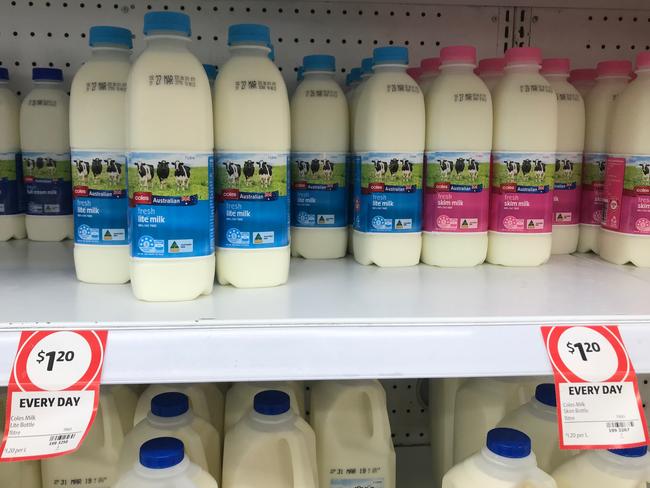Former NRL star Ian Hindmarsh faces losing dairy farm to drought
He spent eights years as an NRL player — sinking every last dollar he made into his dairy farm. But now Ian Hindmarsh fears he will be left with no choice but to walk away. And he is not alone — with one NSW dairy farmer a week walking off the land.
Becoming a dairy farmer has lost former NRL second-rower Ian Hindmarsh all the money he earned in eight years as a professional rugby league player.
The father-of-two wishes he gambled his earnings away instead of pursuing his lifelong dream to be a dairy farmer. He would have had more fun as the money vanished.
He bought the 400-acre property in 2002 during his first stint with the Parramatta Eels and built himself a dairy, before the industry soured.
“I may as well have gambled away the money from playing football, because at least I would have had a life away from the farm,” Hindmarsh, 42, told The Sunday Telegraph.
“If I didn’t build a dairy on my farm, I’d be debt free and I could have a life.”

The drought has increased costs on his Cowra dairy farm in Central West NSW by 40 per cent. Hindmarsh’s dairy, with 330 milking cows, is still running but he fully expects the bank will foreclose on his business before he’s able to return to profit, unless the supermarkets greatly increase what they pay for milk.
Cod squad joins fight to stave off ‘fish Armageddon’
Day zero: The dates we will run out of water
The Hindmarsh family has been continuously milking cows in Australia for more than 170 years and Ian maintains dairy farming is in his blood, but under the current market conditions he doesn’t want his children Dekota, 13, and Flynn, 12, to continue the family business.
Hindmarsh has taken out a bank loan to finance feed for his cattle for the next 12 months, because there hasn’t been enough rain to grow pasture.
In an average year, he would not need to buy any animal feed because he would typically grow enough rye grass, wheat and lucerne.


The price of grain has skyrocketed 80 per cent and hay has doubled in the past 18 months as the drought worsened, although the price of milk hasn’t increased.
Unlike other financially stressed dairy farmers, Hindmarsh can’t afford to sell his milking cows and reinvest in beef cattle or crops because any earnings won’t cover his debts.
“Things are pretty well f … ed,” he said. “There’s just no cream in dairy.
“I can go on as long as my bank manager can keep looking after me. One day I’ll crack it and walk away.
“My wife and I have too much debt to retain our farm, so we’ll have to sell everything and we won’t have the money to buy back in.”


Valuable milking cows being sold to abattoirs for meat reveals the dairy industry’s dire problems.
Hindmarsh has sold 70 milking cows “over the hook” for meat. On paper, the value of Hindmarsh’s remaining milking cows has plunged $500,000 in 18 months.
A flood of farmers in the Central West are expected to cash in their chips and leave the industry if and when milking cows regain their premium.


DEVASTATION
The drought is more devastating to the dairy industry than dollar-a-litre milk, with one farm in NSW closing every week.
Last financial year 51 dairy farms closed across the state, according to Dairy Australia figures to be announced next month.
Dairies in NSW are going bust at the fastest rate in more than a decade because farmers without water can’t grow pasture to feed their herds, forcing them to buy hay and grain at prices wildly inflated by the drought.
Farm gate prices for milk have actually increased by about 10 per cent this year but livestock feed costs have jumped between 80 and 100 per cent since 2017.
The monthly milk cheque is not covering costs to keep dairies afloat.
For farmers who survived the major supermarkets’ dollar-a-litre milk campaigns, selling homebrand milk for less than production costs to get shoppers through the door, and deregulation 20 years ago, the drought is considered the straw that broke the camel’s back.
Ads from auctioneers spruiking firesales are being emailed out every week, announcing another farmer who needs to sell their entire milking herd and machinery into a saturated market.

After a lifetime milking cows in the state’s south west, dairy farmer Neil Campbell, 64, from Blighty will walk off the land as soon as he can.
The second-generation farmer, who bought the farm from his father in 1982, doesn’t know what he will do for a job once he sells all 530 Jersey and Friesian cows and two blocks of land.
“If I sell absolutely everything, which will be a challenge, I’ll walk away debt-free,” Mr Campbell said.
“After working 84 hours a week all my life I was planning on retiring in a few year’s time but there’ll be nothing left to retire on.
“I have a daughter, Meghan (23) who works on the farm but she’s young and resilient and she’ll get a job anywhere.”
For the past two years, Mr Campbell has not been allowed to access water he already paid for to irrigate his crops. For most farmers in the region, purchasing additional water on the open market is unaffordable.
He spent $460,000 on livestock feed in the first six months of this year, which he would normally grow himself.
BITING THE BULLET
Since July last year, more than three trillion litres of water has washed past Mr Campbell’s farm, downstream to South Australia and out to the Southern Ocean as part of the Murray-Darling Basin Plan’s guarantee for environmental flows and South Australian farmers.
Even while NSW rivers and dams are running dry, water from the dwindling Hume and Dartmouth dams near Mr Campbell’s property is currently being allowed to flow south for the benefit of South Australia’s environment.
Mr Campbell’s neighbour, Andy Lostroh, sold his entire herd of 260 prized milking cows six weeks ago.

The Lostroh family had been milking cows for 110 years, which made the heartbreaking decision to sell even harder.
“Selling up has been the hardest thing I’ve ever done in my life,” Mr Lostroh said.
“But when you’re making big losses, year after year, you have to bite the bullet.
“I don’t have plans for the farm but doing nothing is better than milking cows, because we’re not losing money every day.”
After a lifetime as a dairy farmer, the 54-year-old has landed a job as a teacher’s aide next term.

NSW Farmers lobbyists expect milk will be trucked in from Victoria, which is a larger milk producing state, to make up the shortfall from local farmers exiting the industry.
Supermarkets will increase the price of milk but it won’t be enough to account for the huge hike in costs crippling farmers, according to Dairy Australia senior analyst John Droppert.
“It’s hard to overstate the impact of the drought; when costs double that leaves dairy farmers in a precarious position,” Mr Droppert said.
“Some farmers are exiting the industry, processors and supermarkets will take a hit, but eventually we’ll see a price increase.
“However water, hay and grain prices have doubled but milk prices won’t double, so everyone’s going to take a haircut along the way.”



